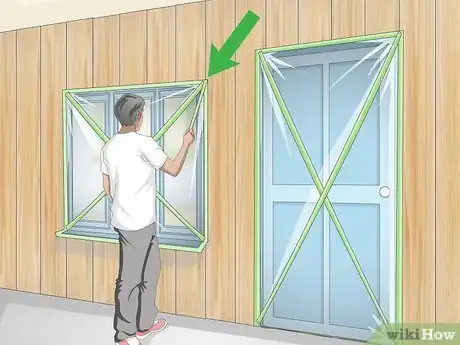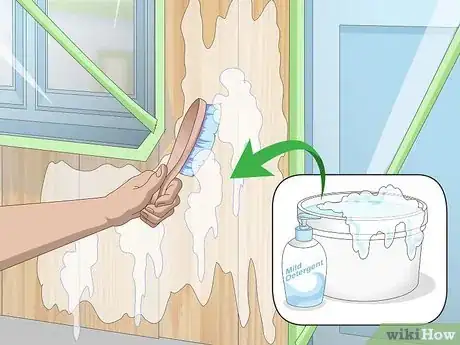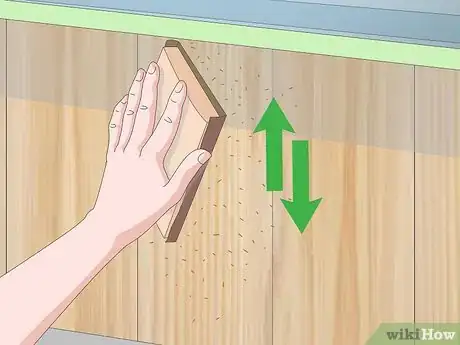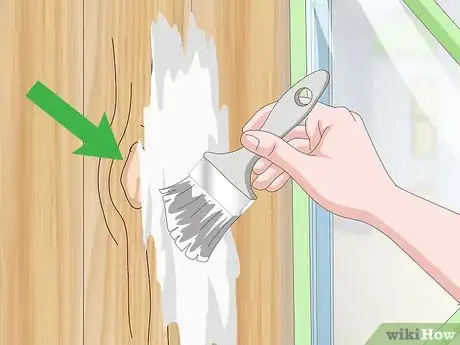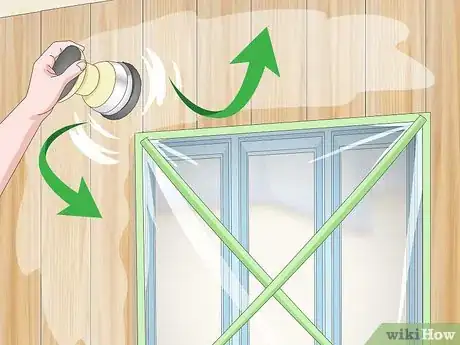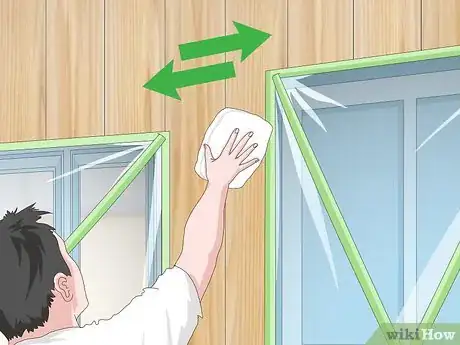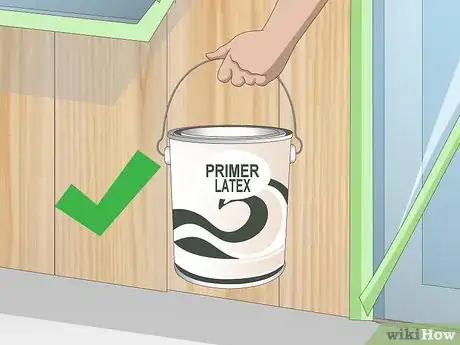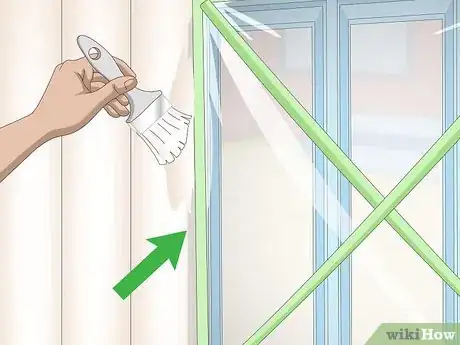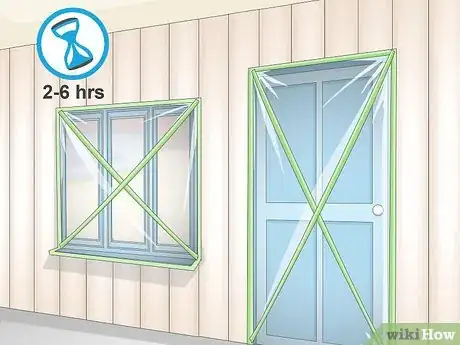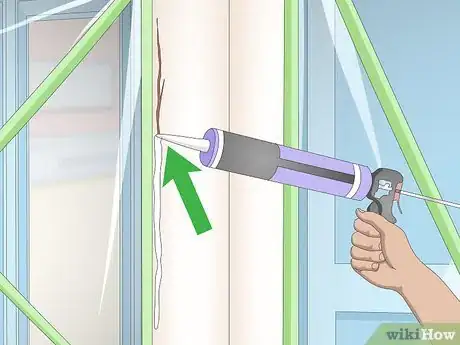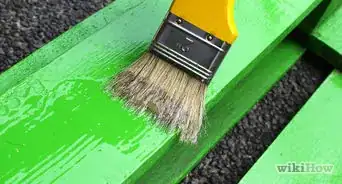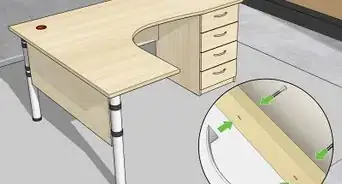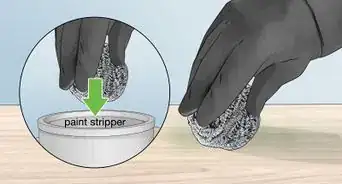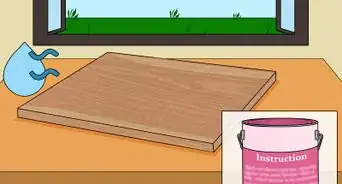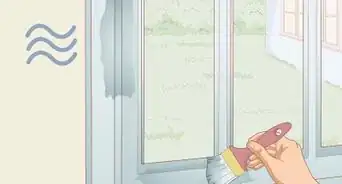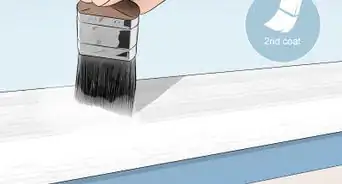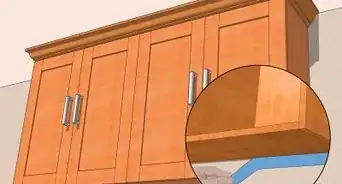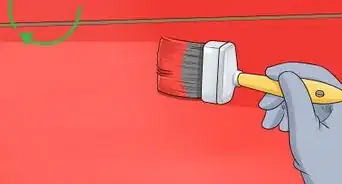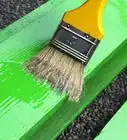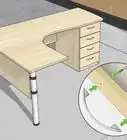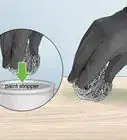This article was co-authored by Andres Matheu. Andres Matheu is the Owner of Hömm Certified Painting Systems, an Interior and Exterior Residential painting business based in the Washington, DC Metro area. Andres specializes in interior and exterior residential painting, color consultations, cabinet refinishing, wallpaper removal, and epoxy flooring among other services. An EPA Lead-safe Certified Firm, Hömm Certified Painting Systems has been awarded the Best of Houzz 2019 Service, Angie's List Super Service Award 2019, and Northern Virginia Magazine's 2018 Best Home Experts (painters) award.
There are 13 references cited in this article, which can be found at the bottom of the page.
This article has been viewed 92,885 times.
Getting an outdoor wood surface ready for a fresh coat of paint isn’t difficult, but it does require a little prep work to ensure that the new paint has a smooth, stable surface to cling to. Your first step will be to give the entire surface a thorough cleaning to remove the stubborn dirt and grime that’s built up over the years. Next, move on to patching holes and cracks with a strong wood filler and scrape flaking paint to clear the way for the new coat. Finish by priming the surface with a resilient exterior primer and using caulk to seal any openings that could leave the wood vulnerable to the elements.
Things You Should Know
- Cover openings with plastic, thoroughly wash the wood, and patch holes (including nail holes) with wood filler.
- To prepare wood for paint, scrape off flaking paint, treat knots with the necessary specialized primers, sand the entire surface, and wipe the surface clean.
- Brush on a coat of latex-based primer, allow the primer to dry completely for 2-6 hours, and if there are gaps and cracks, seal them with caulk.
Steps
Cleaning and Repairing the Wood
-
1Mask any doors, windows, or other openings with plastic. Before you begin scrubbing, scraping, and sanding, take a few minutes to make sure your work area is protected. Cut sheet plastic to fit over each opening and secure the edges using painters tape. Not only will this keep the areas you don’t want to paint covered, it will also help protect more delicate fixtures from damage.[1]
- It may be a good idea to lay some sheeting at the base of the structure as well to catch wood shavings or flecks of paint that come loose during the project.
-
2Clean the wood surface thoroughly. Use a long-handled scrubber brush and a mild detergent to gently scrub away accumulated dirt, grime, mold, and other residue. When you’re satisfied with the wood’s appearance, rinse the exterior from top to bottom with a garden hose. Give the surface a full day to dry before moving on.[2]
- Whatever you're painting has to be clean of any grease, dirt, or debris before you can paint it. Remember to check for things like vine roots that might be growing along the surface, as well.[3]
- Pressure washing may be a more efficient option for renewing larger surfaces, especially areas like fences that may have algae, moss, or mildew growth.[4] Pressure washers are typically available to rent at hardware stores and home improvement centers.[5]
- Avoid using stiff brushes or scrubbers like steel wool. It’s possible for these tools to leave behind permanent scratches in softer woods.
Advertisement -
3Patch large holes and gouges with wood filler. Apply the filler material using the tip of a putty knife or hand trowel, then go over it with the flat edge to smooth it. Smaller spots can be treated the same way, or you can purchase an exterior spackling compound, which won’t require any additional mixing. For most basic applications, the wood filler will dry in a few hours.[6]
- Two-part resin systems tend to stick to exterior wood better than ordinary fillers.
- Repairing damaged and uneven areas to ensure that the surface you’re painting is uniform and structurally sound.
-
4Fill visible nail holes. While you’ve got your wood filler handy, spread a small glob into any recessed nail holes you come across, then carefully blend the material into the surrounding surface. Bringing the holes to level will keep them from being visible under the new paint.[7]
- If there are any nails sticking out of the exterior, remove them (if they’re not necessary) or drive them 1⁄4 inch (0.64 cm) into the face of the wood to get them out of the way before filling the holes.[8]
Preparing the Surface to Accept Fresh Paint
-
1Scrape off flaking paint. If you’re going to be refinishing a surface that’s been painted previously, it will first be necessary to take off any worn patches of paint that might interfere with the new coat. Run a hooked scraper along the places where the old paint is peeling to shave it away. Make sure you keep your strokes moving with the grain—otherwise, you run the risk of splintering the wood.
- Continue scraping until there are no protrusions on the face of the exterior.
- The sharper the scraper, the easier it will be to remove the failing paint. For best results, equip yourself with a scraper that has a hardened steel or carbide edge.[9]
-
2Sand down the edges of bare spots. After scraping, you’ll notice that the remaining paint forms a ridge around the exposed wood. You can do away with these imperfections easily using a handheld power sander. Start with a low-grit sandpaper of around 60-grit or so to grind down sharper edges. Then, switch to a high-grit paper (100-grit or higher) and smooth the paint down to the underlying wood.[10]
- It’s not necessary to sand the contours all the way down to the wood—just “feather” them lightly so that the edges gradually disappear.
- If ignored, old paint lines can create seams under the new topcoat, which can become prone to cracking as a result.
-
3Treat exposed wood knots separately with a preliminary primer. Certain types of wood, like pine and cedar, give off sappy resins that can bleed through thin and light-colored paints. These spots should be brushed with a special resin-blocking primer to prevent discoloration. Apply the primer over any sections of the wood where the grain looks particularly dark or wet.[11]
- Even with a resin-blocking primer, it’s advisable to use 2-3 coats to conceal potential bleeding when it comes time to paint the surface.
-
4Sand the entire surface. Sweep an orbit sander over the wood in wide circular strokes. The light scuffing action will produce a more textured surface that promotes proper paint adhesion.[12]
- Be sure to hit corners, recesses, molding, and any other features you intend to paint, as well.
- Be sure to sand away any wood splints, as well.[13]
- It’s not necessary to remove the old paint. A thorough sanding should rough up the exterior enough to help fresh coats stick.
-
5Wipe the surface clean. Sweep the wood with a stiff-bristled brush or dry cloth to remove the dust generated by sanding. Blow sharply to force lingering dust out of narrow cracks and holes. The surface should be totally free of debris when you're finished.[14]
- A shop vacuum with a brush attachment might help you collect more dust from broad areas.
- Drag your finger along the wood to make sure no traces of dust remain. Paint has a hard time adhering to surfaces that are coated with lots of fine particles.
Priming the Wood Surface
-
1Choose a latex-based primer designed for exterior use. These products hold up better to the sort of heat, moisture, rubbing, and swelling that outdoor wood surfaces are often subjected to. They have the ability to flex a little, which makes them less likely to crack than paints that dry into a hard shell. As a result, your paint job will look better and last longer.[15]
- You should be able to cover about 400 square feet (about 37 square meters) with a single gallon of primer.
- Make sure it's between 50–90 °F (10–32 °C) outside when you apply the primer. If it's too hot or too cold, it may not dry with the right consistency.[16]
-
2Brush on a coat of primer. A roller will make it easier to spread the primer over broader areas. For smaller surfaces and tricky structures like railings, a handheld brush will offer the greatest amount of control. Apply the primer in an even layer thick enough to completely conceal the wood grain underneath.[17]
- Use the tip of the brush to work the primer deeper into dips and divots in rich wood grain.
- Start at the top of the structure and work your way down. That way, any drips will be erased as you go back over them.
-
3Touch up missed spots. When you’re done priming, inspect the surface for any spots, seams, or bare patches you may have overlooked. A few strokes with a handheld brush will make them disappear.
- Paint may peel or wear away faster in places without a primer foundation.
-
4Allow the primer to dry completely. Most primers will take from 2 to 6 hours to dry to the touch. After about 12 hours, the primer will have set enough to paint over with a followup coat, if desired. To minimize the chances of smudges and transfer, avoid handling the wet primer during this time.[18]
- Leave the primer to dry overnight before applying your first coat of paint to ensure that it has time to absorb into the wood.
-
5Use caulk to fill any visible openings. Once the primer is dry, walk around the structure and look for any gaps or cracks that might cause an issue down the line. Seal each opening using a caulk gun loaded with silicone sealant. The caulk will harden within an hour, keeping the structure off-limits from rain, mold, bugs, and drafts.[19]
- The caulk you use should be paintable, able to withstand both high and low temperatures, and suitable for the materials it’s binding.[20]
- Pay close attention to potential problem areas, like the spaces beneath board laps, around window frames, and in-between trim and siding.
Expert Q&A
Did you know you can get expert answers for this article?
Unlock expert answers by supporting wikiHow
-
QuestionDo I need to sand before painting exterior wood?
 Andres MatheuAndres Matheu is the Owner of Hömm Certified Painting Systems, an Interior and Exterior Residential painting business based in the Washington, DC Metro area. Andres specializes in interior and exterior residential painting, color consultations, cabinet refinishing, wallpaper removal, and epoxy flooring among other services. An EPA Lead-safe Certified Firm, Hömm Certified Painting Systems has been awarded the Best of Houzz 2019 Service, Angie's List Super Service Award 2019, and Northern Virginia Magazine's 2018 Best Home Experts (painters) award.
Andres MatheuAndres Matheu is the Owner of Hömm Certified Painting Systems, an Interior and Exterior Residential painting business based in the Washington, DC Metro area. Andres specializes in interior and exterior residential painting, color consultations, cabinet refinishing, wallpaper removal, and epoxy flooring among other services. An EPA Lead-safe Certified Firm, Hömm Certified Painting Systems has been awarded the Best of Houzz 2019 Service, Angie's List Super Service Award 2019, and Northern Virginia Magazine's 2018 Best Home Experts (painters) award.
Commercial Painter
Warnings
- Attempting to sand, patch, or prime wood while it’s still damp could prevent proper adhesion or even cause unintended structural damage.⧼thumbs_response⧽
- If the structure you’re working on was last touched up before 1978, it’s possible that the paint contains lead. In this case, it will be safest to remove every last trace of the old paint. Pick up a home lead-testing kit to determine whether it will be necessary to completely strip the surface prior to layering on a fresh coat.⧼thumbs_response⧽
Things You'll Need
- Long-handled scrubber brush
- Garden hose
- Pressure washer (optional)
- Wood filler
- Putty knife or hand trowel
- Scraper
- Resin-blocking primer
- Latex-based exterior primer
- Paintbrush or roller
- Orbital power sander
- 60-to-100-grit sandpaper
- Caulk gun w/ silicone caulk
- Sheet plastic
- Painter's tape
References
- ↑ https://www.thisoldhouse.com/how-to/putting-fresh-coat-paint-your-exterior
- ↑ https://www.houzz.com/ideabooks/17268616/list/how-to-wash-your-house
- ↑ Andres Matheu. Commercial Painter. Expert Interview. 28 July 2020.
- ↑ Andres Matheu. Commercial Painter. Expert Interview. 28 July 2020.
- ↑ https://www.familyhandyman.com/painting/tips/painting-preparation-making-paint-last-prepare-the-surface/view-all/
- ↑ https://www.bobvila.com/articles/how-to-use-wood-filler/#.Wmtr9qinHIU
- ↑ http://www.planitdiy.com/how-to/painting-decor/how-to-paint-a-house-exterior-paint-preparation/
- ↑ https://www.bobvila.com/articles/how-to-prepare-wood-for-painting/#.WmzS46inHIU
- ↑ https://www.familyhandyman.com/painting/tips/painting-preparation-making-paint-last-prepare-the-surface/view-all/
- ↑ https://www.familyhandyman.com/painting/tips/painting-preparation-making-paint-last-prepare-the-surface/view-all/
- ↑ https://www.familyhandyman.com/painting/tips/painting-preparation-making-paint-last-prepare-the-surface/view-all/
- ↑ http://www.planitdiy.com/how-to/painting-decor/how-to-paint-a-house-exterior-paint-preparation/
- ↑ Andres Matheu. Commercial Painter. Expert Interview. 28 July 2020.
- ↑ https://www.familyhandyman.com/painting/how-to-prepare-wood-trim-for-a-smooth-paint-job/view-all/
- ↑ https://www.todayshomeowner.com/homeowners-guide-paint-primer/
- ↑ http://www.planitdiy.com/how-to/painting-decor/how-to-paint-a-house-prime-caulk-and-paint/
- ↑ http://www.planitdiy.com/how-to/painting-decor/how-to-paint-a-house-prime-caulk-and-paint/
- ↑ https://www.bobvila.com/articles/how-to-paint-pressure-treated-wood/#.WmzUb6inHIU
- ↑ https://www.ronhazelton.com/tips/how_to_caulk_cracks_and_gaps_outside
- ↑ https://www.homedepot.com/c/caulk_and_sealants_buying_guide_recommendations_for_selecting_and_using_caulks_and_sealants_HT_BG_PA
About This Article
Preparing exterior wood for painting isn’t difficult, but it does require some prep work to ensure that your new paint has a smooth, stable surface to adhere to. Clean the entire surface with soap and water or a pressure washer to remove any dirt and grime that’s built up over time. Once the surface is clean, patch any holes or cracks with a wood filler. This is also a good time to scrape any old, flaking paint off and to sand down old paint lines. You can then sand the entire surface to give it a more textured surface that your paint will easily stick to. When the wood is clean and smooth, use a latex-based primer especially made for exteriors to prepare the surface for a new coat of paint. To learn how to treat large knots in your wood, keep reading!
